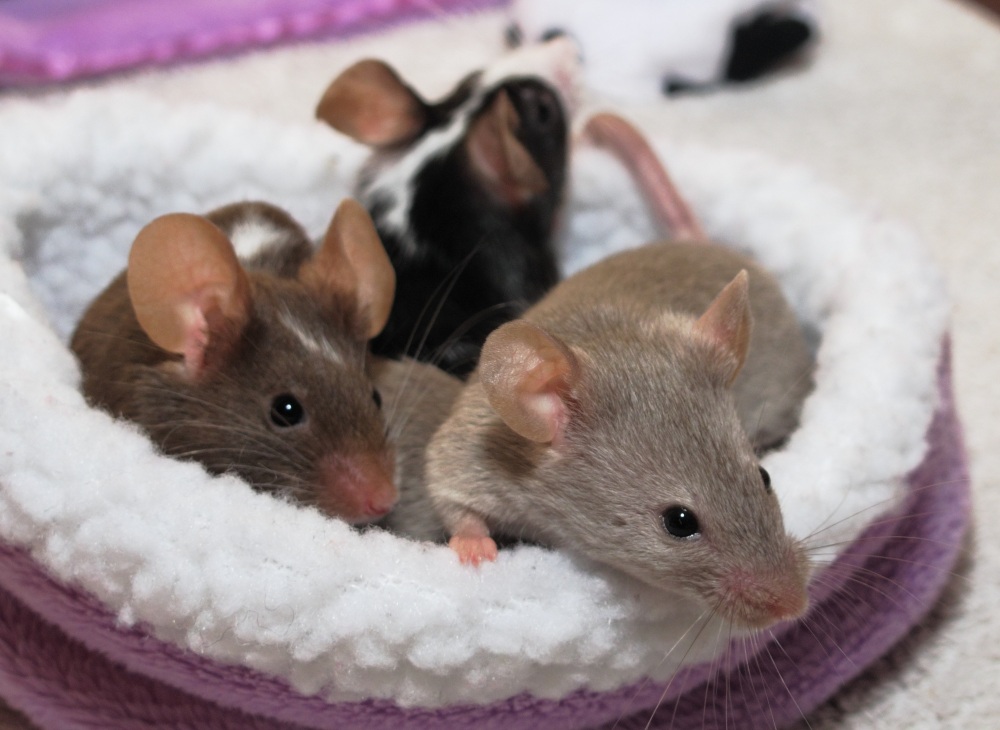
Mice need the company of other mice and usually coexist happily together as long as they have enough space, resources, and opportunities to engage in behaviours they find rewarding, especially chewing and hiding/burrowing.
Here are some guidelines to help you create a harmonious group of mice (a ‘nest’ of mice):
- Ideally, mice should be kept in groups formed before they are weaned, ideally siblings, and the group should not be changed. The optimal weaning age for mice is 18–21 days of age.
- Don’t add or remove mice from an established group, if possible. Adding or removing mice can upset the social organisation of the group and cause conflict and aggression which can result in negative welfare impacts and injury to the mice
- Preferably, only keep mice in compatible single-sex groups. Single sex groups of females usually get on well together. However, keeping intact (non-desexed) adult males together can be a problem as they may be aggressive with one another, so male mice being kept together should be desexed. Although it is not generally recommended to keep males and females together, if you must, the male mice should be desexed. See this article for more information.
- Always try to introduce enclosure-mates to one another before or soon after weaning (at three weeks old) this decreases the likelihood that they will be aggressive towards one another.
- Provide enough resources so that all mice can access them at the same time (such as food bowls, water dishes, chewing and burrowing opportunities, and hiding places), avoiding competition. If there is enough room, ideally the resources should be physically separated from each other also.
- Make sure that males are not able to smell females (if you keep a group of females as well as a group of males). Smelling females may increase aggression between male enclosure- mates.
Note that the dominant mouse may nibble off the whiskers and hair around the eyes and muzzle of the subordinate mice – this is called ‘barbering’. There is just hair loss, no other skin damage and one mouse (the dominant mouse) retains all their hair.
Keep a close eye on your mice, especially after any changes to their environment or movements (e.g. if you remove them from their enclosure to clean it). Disruptions to their smell and environment can trigger aggressive interactions.
Mice should not be kept alone unless this is specifically recommended by your veterinarian as this is very stressful for the mouse. If a mouse must be kept on their own, it is important to take steps to try and safeguard their welfare and you should speak to your vet about this. It might involve ensuring the lone mouse can see, hear, and smell other mice of the same sex and they must also have an optimal environment with lots to do.
If you end up with a mouse on their own because their group members die (which is not uncommon, especially with the short life expectancy of mice), it may be necessary to get a new mouse or mice to keep the remaining mouse company. How can we make this as stress-free and safe as possible?
Things you can do to help reduce aggression (in addition to the guidelines above) include:
- Avoid anything that alters the smell of an individual as this may cause your mice to investigate their enclosure-mate more and could lead to unnecessary aggression. For example, if you need to take one of your mice to the vet, take the others too, or at least one of their enclosure-mates.
- Provide multiple shelters and visual barriers in their enclosure to help break up aggressive encounters by enabling mice to move away from each other.
- Having multiple levels in their home enclosure can also help act as barriers to aggression. Make sure that shelters have multiple exits to avoid particular individuals stopping other enclosure-mates from leaving the shelter.
If fighting between enclosure-mates is occurring, you might observe that one mouse will hide from the others (or specific individuals) and there may be injuries to one or more mice.
It is important to observe your mice even more closely than usual after introducing a new mouse, to watch for signs of trouble. It is not always possible to successfully introduce a new adult mouse to another mouse or group of mice.
When adults who don’t know each other are introduced and housed together there will generally be a period during which there is aggression shown between the mice. However, if the new group dynamic is going to work out, this shouldn’t last long and any aggression should start to reduce as their social dominance relationship settles. If the group of newly introduced mice continue to show aggression towards one another and/or injure each other, this may indicate that the new grouping will not be successful, and they should not continue to be housed together. Keeping mice together who do not get along is detrimental to their welfare and may be dangerous.
Please note that other rodent species, such as rats, are not suitable companions for mice. They may carry diseases which are dangerous to each other and are usually incompatible when sharing resources such as space, food, and shelter. Rats and mice should not be kept in close vicinity to each other, even if in separate housing, as rats are predators to mice and so having rats in the vicinity can be very stressful to mice as the mice sense a predator nearby.
References
Evans E (2006) Small rodent behaviour: mice, rats, gerbils, and hamsters. In: Bays TB, Lightfoot T, Mayer J (eds) Exotic Pet Behavior. W.B. Saunders, pp 239–261
Frohlich J (2020) Rats and mice. In: Quesenberry KE, Orcutt CJ, Mans C, Carpenter JW (eds) Ferrets, rabbits and rodents, 4th ed. W.B. Saunders, pp 345–367

